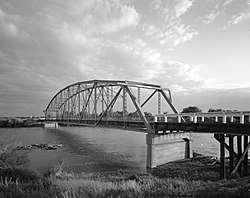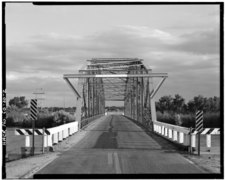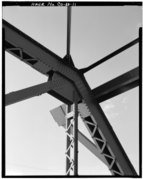Manzanola Bridge | |
|---|---|
 Manzanola Bridge on Colorado State Highway 207 over Arkansas River, Manzanola, Otero County, Colorado, June 1984 | |
| Coordinates | 38°07′38″N103°51′42″W / 38.12713°N 103.86156°W |
| Crosses | Arkansas River |
| Locale | Crowley County, Colorado |
| Other name(s) | Clifton Bridge |
| Characteristics | |
| Design | 18-panel Pennsylvania through truss bridge |
| Total length | 300.0 ft (91.4 m) |
| Width | 19.3 ft (5.9 m) |
| Longest span | 440.0 ft (134.1 m) |
Manzanola Bridge | |
| Nearest city | Manzanola, Colorado |
| Built | 1911 (First Manzanola Bridge) 1950 (Second Manzanola Bridge - moved to new location) |
| Built by | Patterson-Burghardt Bridge Company |
| Architectural style | Truss bridge |
| MPS | Vehicular Bridges in Colorado TR |
| NRHP reference No. | 85001400 [1] |
| Added to NRHP | June 24, 1985 |
| Location | |
 | |
Manzanola Bridge was a truss bridge which was originally built in 1911 by the Patterson-Burghardt Bridge Company over the Colorado River and later moved over the Arkansas River (on Colorado State Highway 207) in the year 1950. [2] The bridge used to connect the town of Manzanola, Otero County, with Crowley County in Colorado.







